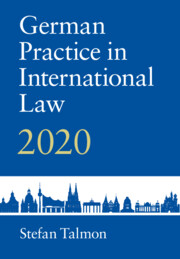Book contents
- German Practice in International Law
- German Practice in International Law
- Copyright page
- Contents
- Contributors
- Preface
- GPIL – German Practice in International Law
- Table of Cases
- Table of German Statutes
- Table of European Legislation
- Table of Treaties
- List of Abbreviations
- 1 Foundations and Functions of International Law
- 2 States and Their Organs
- 3 Inter-State Political and Economic Relations and Transactions
- 4 State Jurisdiction and Immunities
- 5 State Responsibility and Liability
- 6 Antarctica, Sea, Air and Space
- 7 Individuals, Their Human Rights and Their International Criminal Responsibility
- 8 Natural Resources and the Environment
- 9 The United Nations and Other International Organisations
- 10 Use of Force, Arms Control and Disarmament
- 11 International Disputes and Their Settlement
- Annex 1 Notable Statements on International Law by Germany in 2020
- Annex 2 International Agreements Concluded by Germany in 2020
- Index
1 - Foundations and Functions of International Law
Published online by Cambridge University Press: 09 February 2023
- German Practice in International Law
- German Practice in International Law
- Copyright page
- Contents
- Contributors
- Preface
- GPIL – German Practice in International Law
- Table of Cases
- Table of German Statutes
- Table of European Legislation
- Table of Treaties
- List of Abbreviations
- 1 Foundations and Functions of International Law
- 2 States and Their Organs
- 3 Inter-State Political and Economic Relations and Transactions
- 4 State Jurisdiction and Immunities
- 5 State Responsibility and Liability
- 6 Antarctica, Sea, Air and Space
- 7 Individuals, Their Human Rights and Their International Criminal Responsibility
- 8 Natural Resources and the Environment
- 9 The United Nations and Other International Organisations
- 10 Use of Force, Arms Control and Disarmament
- 11 International Disputes and Their Settlement
- Annex 1 Notable Statements on International Law by Germany in 2020
- Annex 2 International Agreements Concluded by Germany in 2020
- Index
Summary
This chapter is concerned with Germany’s perspective on the foundations and functions of international law. It is structured in two parts: international law in general and sources of international law. The second part examines Germany’s view of the Joint Comprehensive Plan of Action (JCPoA) that sought to limit Iran’s nuclear programme. It is argued that the political aims of Germany do not justify the twisting of international law. The Federal Government portrayed the document as a binding international treaty. It did so by speaking of an ‘agreement’, from which the US had decided to ‘withdraw’ and by depicting the participants as ‘parties’. Further, Germany argued that Iran is bound by ‘obligations’ under the JCPoA. Germany also spoke of ‘Articles’ in the JCPoA and asserted that the document was ‘signed’. Moreover, Germany argued that the JCPoA became international law through the endorsement of the UN Security Council. However, the UN Security Council never marked its endorsement as a binding decision. Four and half years after the adoption of the JCPoA, Germany admitted that the JCPoA constitutes only a record of mutual political commitments and is therefore ‘soft law’.
Keywords
- Type
- Chapter
- Information
- German Practice in International Law2020, pp. 1 - 7Publisher: Cambridge University PressPrint publication year: 2023



